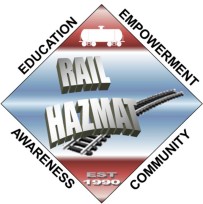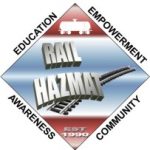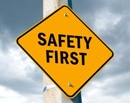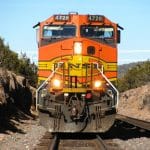WASHINGTON – The Federal Railroad Administration (FRA) today announced a final rule to improve employee safety on freight trains transporting hazardous materials. The rule requires railroads to provide emergency escape breathing apparatuses (EEBAs) for train crew members and other employees who could be exposed to an inhalation hazard in the event of a hazardous material, or hazmat, release. Railroads must also ensure that the equipment is maintained and in proper working condition and train their employees in its use. This rule was advanced after the Norfolk Southern derailment in East Palestine.
“As FRA continues to advance rail safety and address concerns related to the transportation of hazardous materials, this new rule will implement needed protections for the workers who transport these products around the country,” said FRA Administrator Amit Bose. “The safety needs and benefits of EEBAs have long been established by past tragedies and research, and this rule will provide rail employees with the knowledge and tools to minimize potential dangers.”
Although casualties and fatalities caused by inhalation of hazmat are rare, train crew fatalities in 2004 and 2005 resulting from chlorine gas inhalation demonstrated that employee protections are necessary. The final rule fulfills the mandate in the Rail Safety Improvement Act of 2008 that FRA issue regulations requiring railroads to provide EEBAs and training in their use. The rule also addresses similar recommendations made by the National Transportation Safety Board.
As part of this final rule, FRA conducted a Regulatory Impact Analysis (RIA), which presents estimates of the costs likely to occur over the first 10 years of industry’s compliance with the final rule. The RIA will help facilitate railroads’ implementation of the rule’s requirements for EEBAs. As part of the benefits of the new rule, the analysis finds that in addition to heightened safety and the prevention of injuries for covered employees, it will allow for earlier public notification in the event of hazmat releases.
The final rule on Emergency Escape Breathing Apparatus Standards is on public inspection in the Federal Register here and will be published tomorrow.
Tag: hazmat
The Pipeline and Hazardous Materials Safety Administration (PHMSA) has granted Energy Transport Solutions LLC of Doral, Fla., a special permit that allows for the transport of liquid natural gas (LNG) on a route from Wyalusing, Pa., to Gibbstown, N.J.
U.S. Rep. Peter DeFazio of Oregon and U.S. Rep. Tom Malinowski of New Jersey, both members of the House Committee on Transportation and Infrastructure, responded with disappointment to the PHMSA announcement Dec. 6.
“News of PHMSA’s decision to jump ahead of its notice of proposed rulemaking on moving LNG by rail and grant a special permit to Energy Transport Solutions, LLC to move LNG by rail tank car is deeply disturbing,” DeFazio said. “This reckless move by the Administration puts communities in harm’s way. For months I have been sounding the alarm on this dangerous plan. Not only has PHMSA failed to take the proper steps of testing, analyzing or reviewing this unprecedented plan, it failed to provide Congress and the public the opportunity to consider whether the permit’s operating conditions sufficiently address the potential safety implications — an opportunity that’s required by law. The agency rushed its job, spending a measly six months considering this petition and the nearly 3,000 public comments it received.
“In June, Congress passed my amendment to prohibit DOT from finalizing the LNG by rail rule that President Trump intends to rush through in 13 months. I urge the Senate to work with us to put a stop to these irresponsible actions.”
Malinowski said the agency has ignored safety concerns expressed by multiple groups.
“The movement of LNG by rail tank car presents unique and substantial risks to public safety and the environment. This decision by the Department of Transportation to allow LNG to move in large volumes without adequate safeguards is irresponsible, and yet another example of the Administration putting corporate interests over the safety of the American public,” he said.
The north-to-south route is about 175 miles. It runs from fracking shale wells in northern Pennsylvania to a port in New Jersey and likely will be served by Norfolk Southern, the Philadelphia Inquirer reported. The permit expires in November 2021 and allows for no intermediate stops on the route when the LNG is being transported.
Read an article about the permit from the Philadelphia Inquirer.
Read the special permit issued by PHMSA.

The classes are to be held Oct. 20-25; Jan. 12-17; Feb. 2-7 and Mar. 15-20, 2020 at the Val Jahnke Training Facility located at 8030 Braniff St., Houston, TX 77061. All classes are from 7 a.m. to 4 p.m. There will be a Sunday evening orientation at 5:30 p.m. the evening before each class starts. This class should only be taken every three years. Please do not register if you’ve done so in the past three years as space is limited.
The Rail Workers Hazardous Materials Training Program was originally funded in 1990 by the National Institute of Environmental Health Sciences (NIEHS) to provide hazardous materials training for rail workers. Since that time, over 27,000 workers have participated in NIEHS-funded training courses that address requirements of OSHA 1910.120 and DOT’s Hazardous Materials Regulations (49 CFR, Part 172, Subpart H). In 2008 the program received additional funding from the US Department of Transportation to conduct Hazardous Material Instructor Training courses.
The funding provides the following student expenses: travel, lodging and meals. In addition, an incentive of $175.00 per day is available to all training participants of these programs, except those who are able to secure regular pay through their employer, or are paid union officers.
Generally, rail workers do not have the same access to quality hazmat and/or basic safety and health training as workers in many other industries. Both FRA and OSHA share jurisdiction in regulating worker safety and health conditions on railroad property. This joint jurisdiction has generally not been integrated into employer-provided training for rail workers, leaving the majority largely untrained or undertrained to safely perform hazmat-related functions consistent with the requirements set forth by OSHA and DOT. This target population of approximately 150,000 conductors, engineers, brakemen, switchmen, carmen, signalmen, laborers, boilermakers, dispatchers, and maintenance of way workers is represented by the nine rail union affiliates of this cooperative effort
The goal of this training initiative is to provide rail workers with the skills and knowledge necessary to protect themselves, the community, and the environment in a hazardous materials transportation emergency. To achieve this goal, the Rail Workers Hazardous Materials Training Program provides rail workers, through quality hazardous materials training courses, the confidence in their knowledge and problem-solving skills to enable them to make the change for safer work conditions.
Much of the training is provided by peer instructors who are full-time rail workers — members and/or local officers of affiliated rail unions.
Click here to register.

The Rail Workers Hazardous Materials Training Program is funded to provide this training by a federal grant from the National Institute of Environmental Health Sciences (NIEHS). This five-day hazmat training course will provide rail workers the essential knowledge, skills, and response actions in the case of an unintentional release. These tools will allow rail workers to protect themselves, their co-workers and their communities.
The funding provides the following student expenses: air travel, lodging and meals. In addition, an incentive of $175.00 per day is available to all training participants of these programs, except those who are able to secure regular pay through their employer, or are paid union officers.
The dates of the training class are as follows:
- November 12-17, 2017
- January 7-12, 2018
- February 11-16, 2018
- March 18-23, 2018
Training will be conducted at the Houston Fire Department’s Val Jahnke Training Facility, 8030 Braniff Street Houston, TX 77061.
Programs begin Sunday evenings* at 5:30 p.m. and conclude Fridays at 1:00 p.m. Students may be asked to travel on Saturdays to meet program start times or where substantial reductions in airfare warrant. When registering, please select dates in order of preference:
Click here for a printable information sheet.
Click here to register for classes.
For phone inquiries please call 202-624-6963, Monday through Friday, between the hours of 9 a.m. and 5 p.m. EST.

The class is being held Friday, June 3, 2016, from 7:30 a.m. to 5:30 p.m. at the SMART TD Minnesota State Legislative Board office, United Labor Centre, 312 Central Avenue SE, Room 217, Minneapolis, MN 55414. There is a $175.00 stipend for attendees. Lunch will be provided by the legislative board.
The class is limited to the first 30 railroad workers. Click here to register.

Read the entire article from the Claims Journal Dec.8.

The state’s Department of Environmental Protection on Wednesday declined a reporter’s request for monthly volumes of crude oil shipped by rail, citing a June law that prohibits emergency responders from disclosing certain details about rail shipments of hazardous materials through the state.
Read more from the Bangor Daily News.
Railroad has tentatively agreed to pay $71,700 for faililng to timely report leaks of crude oil along the state’s railway system

Read more from The Seattle Times.

The commodities these tank cars carry are wide and varied, almost a who’s who of the chemical industry. And yes, some of them are dangerous.
A recent CSX tank train rolling through the crossing on Liberty Street at Middlebrook Pike offered a virtual montage of commodities shipped regularly by rail through Knoxville: LP gas, hot molten sulfur, isopropyl alcohol, piperidine and more, all identified by their four-digit hazmat code numbers displayed in a diamond-shaped sign on each car’s side.
Read more from the Knoxville News Sentinel.

Local officials — recalling the 1986 Miamisburg train derailment — joined Sen. Sherrod Brown, D-Ohio, as he stressed the need to pass a bill that would require higher national safety standards for rail movement of hazardous materials.
“We’re better prepared than we used to be. (But) there’s still some things we need to do,” Brown said.
Read more from Dayton Daily News.